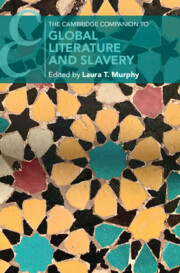Book contents
- The Cambridge Companion to Global Literature and Slavery
- The Cambridge Companion to Global Literature and Slavery
- Copyright page
- Contents
- Contributors
- Acknowledgments
- Chronology
- Introduction
- Part I Contexts and Contestation
- Part II Forms and Figures
- Part III Legacies and Afterlives
- Chapter 8 Slavery and the Virtual Archive: On Iran’s Dāsh Ākul
- Chapter 9 Impossible Revolutions? The Contemporary Afterlives of the Medieval Slave Rebellion of the Zendj
- Chapter 10 Slavery and Indenture in the Literatures of the Indian Ocean World
- Chapter 11 Rehearsing the Past
- Part IV Metaphors and Migrations
- Further Reading
- Index
- Cambridge Companions To …
Chapter 10 - Slavery and Indenture in the Literatures of the Indian Ocean World
from Part III - Legacies and Afterlives
Published online by Cambridge University Press: 15 December 2022
- The Cambridge Companion to Global Literature and Slavery
- The Cambridge Companion to Global Literature and Slavery
- Copyright page
- Contents
- Contributors
- Acknowledgments
- Chronology
- Introduction
- Part I Contexts and Contestation
- Part II Forms and Figures
- Part III Legacies and Afterlives
- Chapter 8 Slavery and the Virtual Archive: On Iran’s Dāsh Ākul
- Chapter 9 Impossible Revolutions? The Contemporary Afterlives of the Medieval Slave Rebellion of the Zendj
- Chapter 10 Slavery and Indenture in the Literatures of the Indian Ocean World
- Chapter 11 Rehearsing the Past
- Part IV Metaphors and Migrations
- Further Reading
- Index
- Cambridge Companions To …
Summary
Theorizations of slavery in the Indian Ocean world often draw upon analyses of enslavement in the anglophone Black Atlantic world, productively highlighting continuities between systems of unfree labor migration across oceans. This chapter, however, focuses mainly on how enslavement in the Indian Ocean diverged from Atlantic models, and the implications this has had for the literatures of slavery. If the anglophone Black Atlantic can be considered a sphere of autobiographical speech and legal silence, the Indian Ocean world of enslavement is one of autobiographical silence, but legal speech. The rich heteroglossia of Indian Ocean legal records stands in contrast to portrayals of the Atlantic Ocean slave trade as a process of silencing and erasure. The existence of these legal records affects the representation of the enslaved in later, fictional narratives of slavery, which share an interest in voice, testimony, and the law. After a brief summary of the historical contexts of slavery in the Indian Ocean world, this chapter examines depictions of enslaved voices in legal archives and fictional works. The final section turns to literatures of indenture, a more recent form of coerced labor migration, to suggest why we should not consider indenture as simply a continuation of slavery.
Keywords
- Type
- Chapter
- Information
- The Cambridge Companion to Global Literature and Slavery , pp. 164 - 184Publisher: Cambridge University PressPrint publication year: 2022

